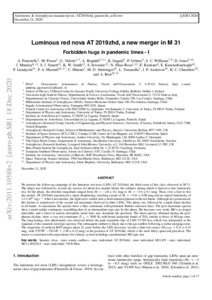Forbidden hugs in pandemic times: I. Luminous red nova AT 2019zhd, a new merger in M 31
Pastorello A; Fraser M; Valerin G; Reguitti A; Itagaki K; Ochner P; Williams SC; Jones D; Munday J; Smartt SJ; Smith KW; Srivastav S; Elias-Rosa N; Kankare E; Karamehmetoglu E; Lundqvist P; Mazzali PA; Munari U; Stritzinger MD; Tomasella L; Anderson JP; Chambers KC; Rest A
https://urn.fi/URN:NBN:fi-fe2021042821617
Tiivistelmä
We present the follow-up campaign of the luminous red nova (LRN) AT 2019zhd, the third event of this class observed in M 31. The object was followed by several sky surveys for about five months before the outburst, during which it showed a slow luminosity rise. In this phase, the absolute magnitude ranged from Mr=-2.8 +/- 0.2 mag to Mr=-5.6 +/- 0.1 mag. Then, over a four to five day period, AT 2019zhd experienced a major brightening, reaching a peak of Mr=-9.61 +/- 0.08 mag and an optical luminosity of 1.4x1039 erg s-1. After a fast decline, the light curve settled onto a short-duration plateau in the red bands. Although less pronounced, this feature is reminiscent of the second red maximum observed in other LRNe. This phase was followed by a rapid linear decline in all bands. At maximum, the spectra show a blue continuum with prominent Balmer emission lines. The post-maximum spectra show a much redder continuum, resembling that of an intermediate-type star. In this phase, Hα becomes very weak, Hβ is no longer detectable, and a forest of narrow absorption metal lines now dominate the spectrum. The latest spectra, obtained during the post-plateau decline, show a very red continuum (Teff ≈ 3000 K) with broad molecular bands of TiO, similar to those of M-type stars. The long-lasting, slow photometric rise observed before the peak resembles that of LRN V1309 Sco, which was interpreted as the signature of the common-envelope ejection. The subsequent outburst is likely due to the gas outflow following a stellar merging event. The inspection of archival HST images taken 22 years before the LRN discovery reveals a faint red source (MF555W=0.21 +/- 0.14 mag, with F555W-F814W = 2.96 +/- 0.12 mag) at the position of AT 2019zhd, which is the most likely quiescent precursor. The source is consistent with expectations for a binary system including a predominant M5-type star.
Kokoelmat
- Rinnakkaistallenteet [27094]
